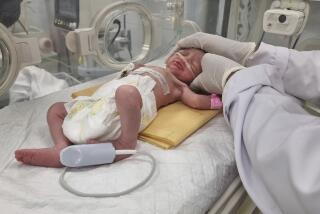Fate of ‘flower of Syria’ offers cautionary tale
Reporting from Beirut — Fatat Malouk said she has no doubt: The burned, mutilated and seemingly unrecognizable body parts that she viewed in a Syrian military hospital in September were the remains of her child — the victim, she said, of government thugs who snatched the teenager off the street.
“My heart tells me this was my daughter,” Malouk said.
Her daughter, Zaynab Hosni, 18, was posthumously immortalized as “the flower of Syria,” and her gruesome fate, captured on amateur video, became a graphic rallying cry for the Syrian opposition.
So it came as a shock when a seemingly healthy Zaynab turned up last month on Syrian television.
“I am alive,” declared the veiled young woman, speaking in a monotone and flashing her plastic identity card for the camera.
She hadn’t been abducted, she said, but ran away to escape abuse from her brothers. She was living with relatives in Syria and planning to get married and have children.
It was an extraordinary propaganda coup for the Syrian government, which daily lashes out at sundry media “fabrications” designed to foment sedition amid a bloody crackdown on unrest that has left an estimated 3,500 civilians dead.
The episode was a cautionary tale for journalists, human rights investigators and others who largely have been barred from entering Syria. Instead of their own observation, they must rely heavily on amateur videos, Skype conversations, Facebook postings and other bits of often secondhand information to piece together what is happening in an uprising with competing narratives.
But the story of Zaynab Hosni, from the central city of Homs, a focal point and sectarian fault line of the Syrian uprising, also illustrates the paranoia and suspicion nurtured in more than four decades of autocratic rule.
Conspiracy theories about Zaynab’s fate abound, many centering on the cunning of Syrian intelligence, skilled practitioners of intrigue and obfuscation.
Her older brother Yousef, speaking from a safe house outside the Lebanese capital, said, “There is a level of lies here that no one can imagine.”
xxx
Fatat Malouk, the family matriarch, is a large woman who suffers from high blood pressure. Even before her daughter disappeared, there was sufficient reason for her high stress levels.
The family’s neighborhood, Bab al Siba, was an early hub of antigovernment protests and armed resistance. In this conservative, largely Sunni Muslim district, resentment runs high against President Bashar Assad, standard-bearer of the Alawite sect, an offshoot of Shiite Islam. Secular Alawite loyalists dominate the Syrian security services. Conservative Sunnis are prominent in the opposition.
According to Human Rights Watch, all six of Zaynab’s older brothers fled the family home to escape arrest. Family members said neighborhood raids were frequent and their house was targeted. But the sister, the family said, didn’t participate in demonstrations.
“Zaynab liked to be at home and wanted to get married and have a family,” said a female cousin.
One of Zaynab’s brothers, Mohammed Deeb Hosni, 27, had been an early organizer of antigovernment demonstrations, according to Amnesty International. By the summer, he was a marked man, living on the run, the family says.
Zaynab’s time was spent caring for her ailing mother, the family said. One afternoon in late July, Malouk said, she asked her daughter to go to the pharmacy for some medication.
Later, her brothers said, they heard from someone in the neighborhood that a group of men grabbed a woman who looked like Zaynab, placed her in a car and drove away. The family checked everywhere: hospitals, morgues, police stations, the homes of neighbors, friends and relatives. But there was no sign of her.
At the time, rumors had been circulating of security thugs kidnapping young Sunni women as an intimidation technique. One human rights investigator said both sides in Homs may have seized women as hostages, for leverage or exchanges for male captives.
Amnesty International reported in its initial accounting of the case that Zaynab’s abduction may have been intended to force her brother, Mohammed Deeb, to turn himself in. After her capture, Amnesty International said, the brother “was apparently told on the phone by her captors that she would only be released if he stopped his antiregime activities.”
xxx
Family members say Zaynab had been missing for more than six weeks when, on Sept. 10, they received news of her brother. He had been arrested after a raid that left him with a gunshot wound to the arm, witnesses told the family.
Four days later, the family says it was summoned to pick up Mohammed Deeb’s remains at the Homs Military Hospital. Family members said the body showed signs of having been badly beaten and shot multiple times. They signed the paperwork for the release of the body, including an attestation that he was killed by “armed groups,” standard in Syria, where the government blames political killings on “terrorist” gangs.
The distraught family was hardly ready for the next piece of news. A relative at the hospital mentioned Zaynab’s disappearance to a doctor, who said the hospital had the remains of a young woman, possibly with that name, according to the family’s account. Family members say they were advised to take a few days and prepare themselves. The body had been mutilated.
On Sept. 17, the family says, it returned to the makeshift morgue, where the dismembered remains were laid out on a table, roughly in the correct anatomical position. The head and the arms were badly burned. Nonetheless, Malouk said she recognized her daughter, as did an aunt.
“I could tell by her shape, the form of her legs,” Malouk recounted. “I know my daughter.”
Family members were given no information on who delivered the body and how it had ended up in such a ghastly state. Again, they say they were forced to sign paperwork saying “armed groups” had been the culprit.
They held a small funeral and, not long after, about 40 family members fled Syria.
The macabre story of Zaynab was soon circulating among opposition activists, who urged the family to go public with grisly video they had filmed of her body and burial.
“We felt the world should know: We are not the only family suffering,” said Yousef, the brother.
The disturbing story went viral. A haunting photo of Zaynab in her veil before her apparent death became an emblem of resistance. Demonstrators hoisted her image aloft. “They picked the flower,” read one banner. “From behind it a bud will rise.”
Then Zaynab appeared on Syrian television.
In the 2 1/2 -minute interview, she seemed calm and measured, almost emotionless. Her eyes seemed fixed off camera, where she was possibly being coached. She sat in a nondescript office, a potted plant behind her.
She decided to go public, she explained, after hearing the news of her supposed abduction and death and fearing complications for her future children. She didn’t offer details about the alleged abuse by her brothers. Near the close of the interview, she seemed to wipe a tear.
“I just want to ask my mother to forgive me,” she said.
Yes, the family said, the woman appeared to be Zaynab. But her mother and others said something was off: her voice.
“It is not the voice of my daughter,” said Malouk, as others in the family home nodded in agreement. “That is not the way we speak.”
Relatives said they discerned a subtle inflection associated with Hom’s Alawites. The voice track was often out of sync with the lips.
And, if Zaynab is indeed living with relatives in Syria, why haven’t they heard from her, or from them?
With so many doubts, the family developed its own theory: Zaynab was arrested and interrogated, her questioning videotaped, as is sometimes done with “terrorist” suspects. She was later killed, her body defiled for unknown reasons. Then, when her case became potent opposition propaganda, Syrian authorities reworked the video, dubbing a new voice track.
“I buried my daughter with my own hands,” her mother said. “I know she is dead.”
No expert has validated the family’s theory.
When the video of a beheaded corpse began circulating on the Internet, both Amnesty International and Human Rights Watch issued blistering reports condemning her mutilation as damning evidence of the Syrian regime’s depravity. Her subsequent TV interview prompted both human rights giants to acknowledge that the family may have misidentified the body, because of extreme emotional duress.
“I think it was an honest mistake,” said Nadim Houry, deputy regional director of Human Rights Watch, who investigated the matter. “But we still haven’t gotten to the bottom of the story yet. There are too many unanswered questions.”
In the case of Zaynab, an embattled regime desperate to counter media “falsehoods” managed to dent the opposition-driven narrative of heroic resistance. But, in a murky conflict where truth is difficult to discern, her TV appearance has intensified a poisonous mood of doubt and suspicion.
In the meantime, family members say, no one from the government has contacted them about exhuming the corpse and doing a DNA test.
So the question remains: If it’s not Zaynab, who is the young woman whose dismembered remains were buried in Homs?
Special correspondent Rima Marrouch contributed to this report.
More to Read
Sign up for Essential California
The most important California stories and recommendations in your inbox every morning.
You may occasionally receive promotional content from the Los Angeles Times.










